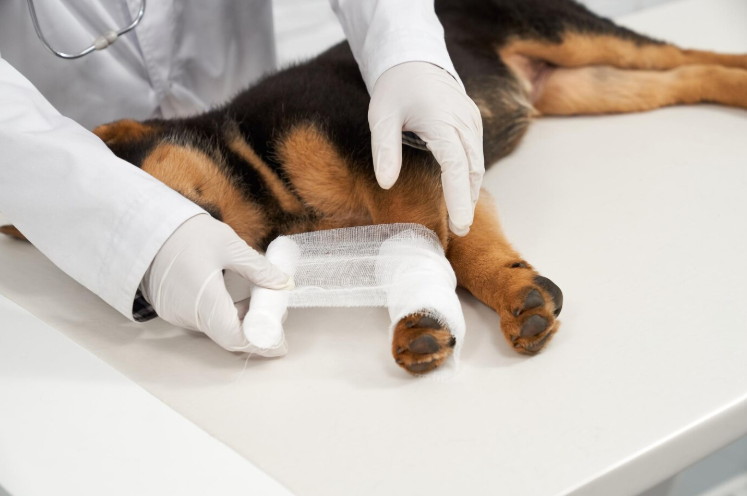When it comes to caring for your pet, unexpected surgeries can be a major concern. Pet insurance can help cover medical costs, but many pet owners wonder if surgery is included.
Common concerns include whether surgeries like emergency procedures, tumor removals, or broken bone repairs are included. On average, surgeries cost $5000 or more, depending on the severity.
In this article, we’ll explore what types of surgeries are covered by insurance, the factors affecting coverage, and how you can manage the costs of your pet’s surgery.
Types Of Pet Insurance Plans & Their Coverage
Pet insurance plans offer different levels of coverage. Some cover only accidents, while others include both accidents and illnesses.

1. Accident-Only Plans
These plans cover surgeries related to accidents, such as fractures, sprains, or injuries from a car accident. If your pet gets hurt in an accident, the policy will cover the cost of necessary surgeries to treat those injuries.
Some Accident-Only plans include Pets Best and Embrace Pet Insurance. They are ideal if you’re looking for coverage against accidents, but they don’t cover illness-related surgeries.
2. Accident & Illness Plans
These plans cover surgeries related to both accidents and illnesses. For example, if your pet needs surgery for a broken bone or a tumor, an accident and illness plan would cover both.
Healthy Paws and Trupanion include Accident & Illness plans. They cover a wide range of surgeries, such as tumor removal or cruciate ligament repair. Moreover, this plan is a great choice if you want broader protection for your pet, helping you manage unexpected accidents and health issues.
3. Comprehensive Plans
Comprehensive plans offer the most extensive coverage, including accidents, illnesses, and sometimes even wellness care like vaccinations and check-ups. Some plans may also cover elective surgeries, such as spaying or neutering if included in the policy.
Nationwide and Petplan offer coverage for routine check-ups, vaccinations, preventive care, and accident and illness treatments. This plan is perfect if you want your pet fully protected for most types of care, from emergencies to routine visits.
What Types of Surgeries Are Typically Covered?
Pet insurance typically covers surgeries necessary for your pet’s health and well-being. This can include emergency, medically necessary, and, in some cases, dental surgeries. Let’s explore these categories:
- Emergency Surgeries: These surgeries are for urgent situations, such as removing foreign objects your pet might swallow or repairing broken bones. They’re covered because they help prevent life-threatening conditions.
- Medically Necessary Surgeries: These include surgeries that are essential for your pet’s health, such as tumor removals or ligament repairs. These surgeries are needed to treat serious health problems and restore your pet’s well-being.
- Dental Surgeries:
Only accidents or medical conditions qualify for dental surgery coverage. This can include extractions or other treatments needed after an injury or a medical problem, not for routine care like teeth cleaning.
What Surgery Expenses Are Included In Coverage?
Pet insurance can cover several related expenses when your pet needs surgery, helping you manage the costs. Here’s a breakdown of what is typically covered:

- Veterinary Consultation Fees: Most pet insurance plans cover the consultation fee the vet charges for evaluating your pet’s condition before surgery. This helps you get a professional diagnosis and recommendation.
- Surgical Procedures: Insurance generally covers the surgery itself, whether it’s for fractures, tumor removal, or emergency procedures. According to sources like Policybazaar, surgery costs are a significant part of coverage in most plans.
- Anesthesia and Medications: Surgery often requires anesthesia, and it’s included in your coverage. Additionally, medications prescribed for post-surgery care, like painkillers or antibiotics, are typically covered by pet insurance.
- Post-Surgery Care: Follow-up visits, hospital stays, and additional treatments after surgery are included in many plans. Pet insurance helps reduce the burden of long-term recovery costs.
- Diagnostic Tests:
Pre-surgery tests like blood work, X-rays, or ultrasounds are also often covered. These tests are essential to ensure your pet is ready for surgery and to diagnose underlying issues.
Source: FutureGenerali.in
What Surgeries Are NOT Covered?
While pet insurance covers many types of surgeries, specific procedures are generally not included in it. These exclusions are typically based on the nature of the surgery or condition.

1. Elective & Cosmetic Procedures
Surgeries like ear cropping, tail docking, and declawing are considered elective and cosmetic rather than medically necessary.
Pet insurance usually doesn’t cover these surgeries as they are not required for your pet’s health, and their primary purpose is appearance or lifestyle preference.
2. Pre-Existing Conditions
Any illness or injury that your pet has before enrolling in a pet insurance policy is not covered.
Insurance providers often exclude coverage for pre-existing conditions since they were not unknown at the time of signing the policy, meaning they won’t be covered under most plans.
3. Routine & Preventative Surgeries
Surgeries like spaying or neutering are usually not covered unless they are included as part of an add-on plan or wellness package.
These surgeries are considered part of routine care to prevent future health problems and are often excluded from standard surgical coverage.
4. Experimental or Non-Essential Procedures
Treatments that are considered experimental or non-essential, like unproven medical treatments, may not be covered.
Insurance policies typically focus on proven, necessary procedures. If a treatment isn’t supported by evidence or widely recognized by vets, it might be excluded from coverage.
How Much Does It Cost For Pet Surgery?
Pet surgery costs can vary widely depending on the type of surgery and your pet’s condition. Below is a table summarizing the average costs of common pet surgeries.
| Surgery Type | Estimated Cost (USD) |
|---|---|
| Spaying (Female Dogs) | $200 – $700 |
| Neutering (Male Dogs) | $20 – $500 |
| Emergency Surgeries | $500 – $3,000+ |
| Orthopedic Surgeries | $1,500 – $4,000+ |
| Cancer Surgery | $1,000 – $5,000+ |
The cost of pet surgery varies significantly based on the type of procedure, your pet’s size, location, and clinic. Emergency surgeries and orthopedic procedures are generally more expensive due to their complexity and the need for specialized care.
Pet insurance is ideal for covering these costs and can ease the financial burden for pet owners who face unexpected surgeries.
The average pet insurance policy may differ according to age, breed, physical condition, and area. You pay only $1500 in a few Pet Insurance firms for veterinarian care.
How Does Pet Insurance Help With Costs?
Pet insurance can significantly reduce the financial strain of surgeries. Depending on the plan, insurance can reimburse 70%, 80%, or even 90% of surgery costs.
However, the amount you pay before insurance can affect out-of-pocket expenses. Annual and lifetime payout limits also determine how much can be reimbursed over time.
These factors can vary by insurer, but having insurance ensures you’re covered for unexpected surgeries, saving you from high expenses. Pet insurance provides peace of mind during emergencies.
Can You Buy Pet Insurance Before Surgery?
You can buy pet insurance before surgery, but the surgery may not be covered if it’s a pre-existing condition. Insurance policies typically cover surgeries after the waiting period, which can range from a few days to several weeks.
Steps To File A Claim For Pet Surgery
To file a pet surgery claim, gather all necessary medical documents, submit the claim through the insurer’s process, and follow up for reimbursement. Each insurance provider may have different procedures.

1. Gathering Medical Records & Invoices
Ensure all veterinary bills and medical records related to the surgery are collected. Accurate documentation is key to smooth claim processing.
Source: Policy Bazaar, Future Generali
2. Submitting the Claim
Submit the completed claim form online or via mail, depending on the insurer’s guidelines. Some providers offer mobile apps for easy submission.
Source: Lemonade
3. Reimbursement Process
Once the claim is approved, reimbursement is generally issued within 10-14 business days. The amount depends on your coverage plan.
Source: Lemonade
Alternative Payment Options For Pet Surgery
Pet owners can explore various options like savings accounts, vet payment plans, or charitable grants to manage surgery costs. These alternatives can make it easier to afford necessary surgeries without relying solely on pet insurance.
Pet Savings Accounts
A pet savings account allows you to save money over time for unexpected medical expenses. This proactive approach helps you avoid financial strain when surgeries or treatments are needed. It is similar to an emergency fund, ensuring your pet’s health needs are met without relying on insurance claims.
Vet Payment Plans
Many vets offer payment plans that allow you to pay for surgeries in installments. These plans can be convenient for pet owners who can’t afford the full amount upfront. It’s important to inquire about interest rates and terms, as well as whether your vet collaborates with financing companies, such as CareCredit.
Charitable Organizations & Grants
Some nonprofit organizations and pet rescue groups offer grants or financial assistance to help cover surgery costs. These programs are often aimed at pet owners in financial distress or those caring for rescue pets. The Pet Fund and RedRover, provide financial support to eligible applicants.
Why Is It Important To Have A Pet Insurance?
Pet insurance ensures you’re covered for unexpected surgeries, health treatments, and emergencies. It can help pay for a variety of procedures, including life-saving surgeries, cancer treatments, and even routine care, depending on your plan.
Beyond surgeries, pet insurance provides peace of mind by covering vet visits, medications, and diagnostics. It reduces financial stress when your pet faces health challenges, making it a worthwhile investment for your pet’s well-being and financial security.
Related Topics:
Conclusion: Pet Insurance Does Cover Specific Surgery
Pet owners should be prepared for unexpected surgical emergencies if essential. Get Pet insurance as it covers a range of surgeries, from accident-related injuries to medically necessary procedures.
It offers financial security during stressful times. With various plans available, researching and selecting the right coverage for your pet’s needs and your budget is crucial.
Consider factors like coverage limits and reimbursement options. Ensure your furry friend receives necessary care without delay.
FAQs
Pet insurance generally does not cover surgeries for pre-existing conditions, as these are considered known risks. It’s important to purchase coverage before any medical issues arise to ensure protection.
Once the claim is processed and approved, reimbursement typically takes 10 to 14 business days. The exact timeline may vary depending on your provider and the complexity of the surgery.
If you don’t have insurance, you’ll be responsible for the full cost of emergency surgery. In such cases, you may explore vet payment plans, savings accounts, or financial aid programs for assistance.
Routine surgeries such as spaying or neutering are often excluded from standard pet insurance policies unless added as an optional rider or included in wellness plans.
Dental surgeries are typically covered if medically necessary, such as tooth extractions due to injury or disease. Cosmetic dental procedures, like teeth cleaning, are usually excluded from coverage.
